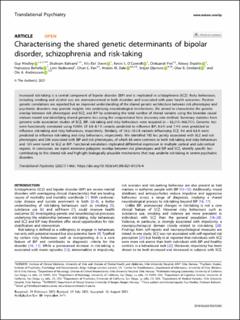| dc.contributor.author | Hindley, Guy Frederick Lanyon | |
| dc.contributor.author | Bahrami, Shahram | |
| dc.contributor.author | Steen, Nils Eiel | |
| dc.contributor.author | O'Connell, Kevin Sean | |
| dc.contributor.author | Frei, Oleksandr | |
| dc.contributor.author | Shadrin, Alexey | |
| dc.contributor.author | Bettella, Francesco | |
| dc.contributor.author | Rødevand, Linn | |
| dc.contributor.author | Fan, Chun-Chieh | |
| dc.contributor.author | Dale, Anders | |
| dc.contributor.author | Djurovic, Srdjan | |
| dc.contributor.author | Smeland, Olav Bjerkehagen | |
| dc.contributor.author | Andreassen, Ole | |
| dc.date.accessioned | 2021-09-22T09:36:12Z | |
| dc.date.available | 2021-09-22T09:36:12Z | |
| dc.date.created | 2021-09-20T13:10:39Z | |
| dc.date.issued | 2021 | |
| dc.identifier.issn | 2158-3188 | |
| dc.identifier.uri | https://hdl.handle.net/11250/2780275 | |
| dc.description.abstract | Increased risk-taking is a central component of bipolar disorder (BIP) and is implicated in schizophrenia (SCZ). Risky behaviours, including smoking and alcohol use, are overrepresented in both disorders and associated with poor health outcomes. Positive genetic correlations are reported but an improved understanding of the shared genetic architecture between risk phenotypes and psychiatric disorders may provide insights into underlying neurobiological mechanisms. We aimed to characterise the genetic overlap between risk phenotypes and SCZ, and BIP by estimating the total number of shared variants using the bivariate causal mixture model and identifying shared genomic loci using the conjunctional false discovery rate method. Summary statistics from genome wide association studies of SCZ, BIP, risk-taking and risky behaviours were acquired (n = 82,315–466,751). Genomic loci were functionally annotated using FUMA. Of 8.6–8.7 K variants predicted to influence BIP, 6.6 K and 7.4 K were predicted to influence risk-taking and risky behaviours, respectively. Similarly, of 10.2–10.3 K variants influencing SCZ, 9.6 and 8.8 K were predicted to influence risk-taking and risky behaviours, respectively. We identified 192 loci jointly associated with SCZ and risk phenotypes and 206 associated with BIP and risk phenotypes, of which 68 were common to both risk-taking and risky behaviours and 124 were novel to SCZ or BIP. Functional annotation implicated differential expression in multiple cortical and sub-cortical regions. In conclusion, we report extensive polygenic overlap between risk phenotypes and BIP and SCZ, identify specific loci contributing to this shared risk and highlight biologically plausible mechanisms that may underlie risk-taking in severe psychiatric disorders. | en_US |
| dc.language.iso | eng | en_US |
| dc.publisher | Nature Research | en_US |
| dc.rights | Navngivelse 4.0 Internasjonal | * |
| dc.rights.uri | http://creativecommons.org/licenses/by/4.0/deed.no | * |
| dc.title | Characterising the shared genetic determinants of bipolar disorder, schizophrenia and risk-taking | en_US |
| dc.type | Journal article | en_US |
| dc.type | Peer reviewed | en_US |
| dc.description.version | publishedVersion | en_US |
| dc.rights.holder | Copyright 2021 the authors | en_US |
| dc.source.articlenumber | 466 | en_US |
| cristin.ispublished | true | |
| cristin.fulltext | original | |
| cristin.qualitycode | 1 | |
| dc.identifier.doi | 10.1038/s41398-021-01576-4 | |
| dc.identifier.cristin | 1936014 | |
| dc.source.journal | Translational Psychiatry | en_US |
| dc.identifier.citation | Translational Psychiatry. 2021, 11, 466. | en_US |
| dc.source.volume | 11 | en_US |

